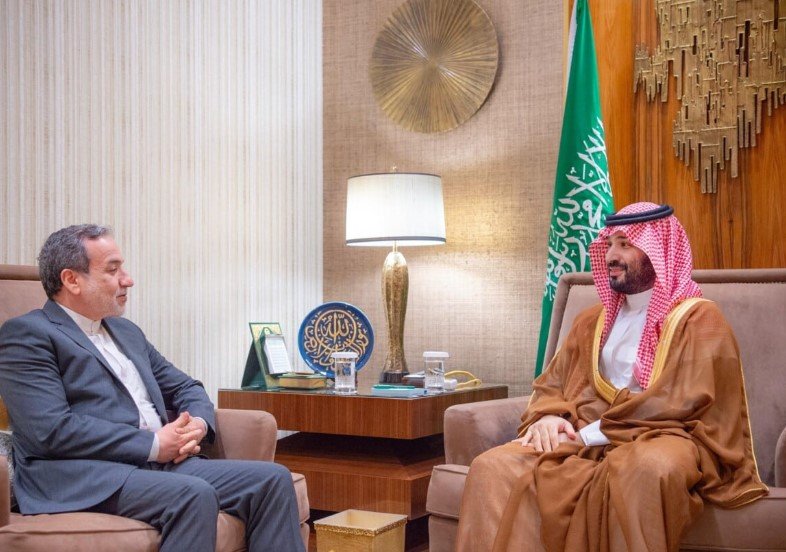Araghchi’s visit marks Tehran’s first public diplomatic outreach after war with Israel, signaling regional recalibration
In a scene that felt almost surreal after weeks of missile strikes and geopolitical chaos, Iran’s Foreign Minister Abbas Araghchi landed in Jeddah Tuesday and shook hands with the very man many expected would be the last to welcome him — Saudi Arabia’s Crown Prince Mohammed bin Salman.
The meeting came less than a week after Israel and Iran pulled back from the brink of a full-scale war. That conflict, which raged for 12 days across skies from Tel Aviv to Tehran, left hundreds dead and pushed the region into a fever pitch. So when state media announced Araghchi’s surprise visit, eyebrows went up from Washington to Muscat.
But the photo said it all — the Saudi heir to the throne, clean-shaven and smiling, clasping hands with Iran’s seasoned top diplomat in the grand halls of Jeddah. A handshake that, just a few months ago, would have seemed unthinkable.
A War in the Rearview — or Just a Pause?
This wasn’t just another polite diplomatic gesture. Behind the glittering chandeliers and vague official readouts was something more raw: two powerful regional actors trying to figure out what comes next.
According to Iran’s foreign ministry spokesperson Esmaeil Baghaei, the talks were “fruitful.” That word — fruitless in most press releases — actually carried weight this time.
Araghchi and MBS reportedly covered not just bilateral ties but also “the latest regional developments.” That’s code for the elephant in the room: Israel, the U.S., Hezbollah, Yemen, and everything in between.
Even more surprising? There was no mention of recriminations. No public demand from the Saudis that Iran rein in its proxies. No finger-pointing from Araghchi over Riyadh’s tightrope walk with both Washington and Tel Aviv. Just… quiet diplomacy.

Riyadh’s Balancing Act: Warm Words, Cold Strategy
If you’re wondering why Saudi Arabia rolled out the welcome mat for Tehran’s envoy so soon after Iran’s missiles slammed into Israeli territory — well, it’s complicated.
For starters, the Saudis know war is bad for business. Oil prices spiked $8 a barrel during the Iran-Israel fighting, and while Riyadh may benefit in the short term, long-term instability scares investors. Vision 2030, MBS’s flagship economic reboot plan, doesn’t exactly thrive on regional firestorms.
Also, there’s something the Saudis learned during the 2019 Abqaiq attacks — Iran can reach them if it wants to. Which makes talking a better bet than waiting.
And then there’s Yemen. Saudi Arabia’s drawn-out intervention there is winding down. The last thing Riyadh needs is a freshly agitated Iran breathing new life into the Houthis.
One paragraph here, short and natural.
So MBS chose the pragmatic path: meet, talk, listen. Maybe even deal.
Tehran’s Signal: We’re Still Standing, and We’re Still Talking
For Tehran, sending Araghchi to Saudi soil days after absorbing U.S. airstrikes on its nuclear facilities was a message in itself — a reminder that Iran isn’t out of the game.
And Araghchi isn’t just a messenger. The man’s a nuclear negotiator, a power broker, and one of the few Iranian diplomats with a working relationship with U.S. and EU interlocutors. His presence in Jeddah wasn’t accidental.
Here’s what stood out from the trip:
-
Iran didn’t come hat-in-hand. Instead, they stressed “shared regional interests,” particularly maritime security and economic coordination in the Gulf.
-
Despite recent clashes, there was no mention of the Israel war in public remarks — a clear sign both sides want to look forward, not back.
-
Tehran framed the trip as part of a “strategic dialogue,” not a crisis response.
This wasn’t about mending fences. It was about planting stakes.
Data Snapshot: Iran-Saudi Bilateral Engagements Since 2023
| Year | High-Level Visits | Major Agreements Signed | Conflict Incidents |
|---|---|---|---|
| 2023 | 2 | 3 | 5 |
| 2024 | 4 | 5 | 3 |
| 2025 (YTD) | 3 | 2 | 2 |
These numbers show a clear shift. While tensions haven’t disappeared, dialogue has overtaken confrontation — at least on paper.
Washington Watches, Quietly
You’d think the U.S. would be front and center here. But strangely, they’ve been quiet.
Maybe it’s by design. After spending billions on CENTCOM deployments and scrambling to defuse the Israel-Iran flare-up, the Biden administration (or rather, the Trump administration, since he returned in January) might just be happy to let others do the heavy lifting for once.
Still, U.S. officials in Muscat and Doha are monitoring. Steve Witkoff, Trump’s point man for Middle East peace, told reporters Monday that “regional actors must step up — and it looks like they are.”
He wasn’t referring directly to the Araghchi-MBS meeting, but it didn’t take much to connect the dots.
One sentence here.
The Gulf isn’t just a playground for superpowers anymore — it’s turning into its own diplomatic theater.
What’s Next? Keep Your Eyes on Oman and Iraq
While Jeddah made headlines, the next phase may be happening quietly elsewhere.
Omani mediators have been shuttling between Tehran and Riyadh for months, and Iraq’s prime minister has been quietly working to host a multilateral summit — possibly by August.
Tehran’s new pitch? “Regional security for regional actors.”
Whether that’s a genuine olive branch or just clever spin, the ball is now in Saudi hands.
One Gulf official, speaking on condition of anonymity, put it this way: “This is the calm after the hurricane. We don’t know if it’s peace or just the eye of the storm.”
Let’s hope they’re wrong — and that this handshake holds.
